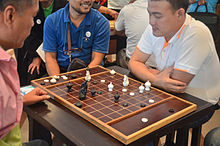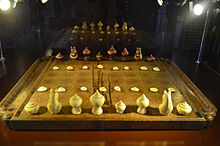
- Chess World Cup
- FIDE Grand Prix
- Olympiad
- World Championship
- List of strong tournaments
- List of world championships

- Checkmate patterns
- Chess openings
- Chess strategy
- Chess tactics
- Chess theory
- Endgames
- Pawn structure
- Problems/Compositions












 |
a | b | c | d | e | f | g | h |  |
| 8 |  |
 |
 |
 |
 |
 |
 |
 |
8 |
| 7 |  |
 |
 |
 |
 |
 |
 |
 |
7 |
| 6 |  |
 |
 |
 |
 |
 |
 |
 |
6 |
| 5 |  |
 |
 |
 |
 |
 |
 |
 |
5 |
| 4 |  |
 |
 |
 |
 |
 |
 |
 |
4 |
| 3 |  |
 |
 |
 |
 |
 |
 |
 |
3 |
| 2 |  |
 |
 |
 |
 |
 |
 |
 |
2 |
| 1 |  |
 |
 |
 |
 |
 |
 |
 |
1 |
 |
a | b | c | d | e | f | g | h |  |
 Makruk Thai players
Makruk Thai players Makruk Thai set 100 years before 2012
Makruk Thai set 100 years before 2012 Makruk Thai set 200 years before 2012 which Bia are made from shells
Makruk Thai set 200 years before 2012 which Bia are made from shells Makruk Thai from early Rattanakosin era with pieces made from albino and black water buffalos' horn
Makruk Thai from early Rattanakosin era with pieces made from albino and black water buffalos' hornMakruk (Thai: หมากรุก; rtgs: Mak Ruk; ), or Thai chess, is a board game descended from the 6th-century Indian game of chaturanga or a close relative thereof, and therefore related to chess. It is regarded as the most similar living game to this common ancestor of all chess variants.
There are around two million Thais who can play makruk, while 5000 can play chess.
According to former world chess champion Vladimir Kramnik, "Makruk Thai is more strategic than international chess. You have to plan your operations with total care since Makruk Thai can be compared to an anticipated endgame of International Chess."
| ○ | ● | ○ | ||
| P | ||||
| ● | ● | |||
| Q | ||||
| ● | ● | |||
| ● | ● | ● | ||
| B | ||||
| ● | ● | |||
| ● | ● | |||
| ● | ● | |||
| KT | ||||
| ● | ● | |||
| ● | ● |
| │ | ||||
| │ | ||||
| ─ | ─ | R | ─ | ─ |
| │ | ||||
| │ |
| ● | ● | ● | ||
| ● | K | ● | ||
| ● | ● | ● | ||
| English | king (1) | queen (1) | bishop (2) | knight (2) | rook (2) | pawn (8) | promoted pawn (queen) |
|---|---|---|---|---|---|---|---|
| Thai | ขุน | เม็ด | โคน | ม้า | เรือ | เบี้ย | เบี้ยหงาย |
| RTGS | khun | met | khon | ma | ruea | bia | bia-ngai |
| Meaning | feudal lord | seed | nobleman/mask | horse | boat | cowry shell | Overturned Cowry Shell |
In starting position, pawns are placed on the third and sixth ranks. Queens are placed at the right side of kings. Pawns promote (เบี้ยหงาย bia ngai, flipped cowry shell) and move like queens when they reach the sixth rank. There is no castling rule like that of international chess.
When neither side has any pawns, the game must be completed within a certain number of moves or it is declared a draw. When a piece is captured the count starts again from scratch only if it is the last piece of one side in the game.
When the last piece (that is not the king) of the disadvantaged side is captured, the count may be started, or restarted from the aforementioned counting, by the weaker side, and the stronger side now has a maximum number of moves based on the pieces left:
The weaker side pronounces aloud the counting of his fleeing moves, starting from the number of pieces left on the board, including both kings. The stronger side has to checkmate his opponent's king before the maximum number is pronounced, otherwise the game is drawn. During this process, the count may restart if the counting side would like to stop and start counting again.
For example, if White has two rooks and a knight against a lone black king, he has three moves to checkmate his opponent (the given value of 8 minus the total number of pieces, 5). If Black captures a white rook, the count does not automatically restart, unless Black is willing to do so, at his own disadvantage. However, many players do not understand this and restart the counting while fleeing the king.
Here are some alternative rules, which do not apply to the standard, formal game, or have been abandoned in professional play. They are called sutras. The first free moves are similar to those in Cambodian Ouk (see below).
 Cambodian men playing Ouk
Cambodian men playing OukThe variety of chess played in Cambodia, called "Ok" (Khmer: អុក) or "Ouk Chatrang" is virtually identical to Makruk, with a couple of minor differences. On the king's first move, a player has the option of moving the king like a knight, but only if not in check and only if no pieces have been captured. On the queen's first move, the player has the option of moving the queen two squares straight ahead - again, only if no pieces have been captured. There is evidence that Ouk Chatrang has been played in Cambodia since the twelfth century, as it is depicted in several reliefs in the Angkor temples.
In the variant "Ka Ok" (aka "Kar Ouk"), the first player to put the other in check wins.
The first Ouk Chatrang tournament was held in Cambodia from April 3 to 4 of 2008, upon the completion of a standardized ruleset by the Olympic Committee of Cambodia and the Cambodian Chess Association.
Mak Horse (Thai : หมากฮอส) Mak horse is a board game you have to think and plan on your turn. Mak horse there are 2 players and have 8 maks. Mak horse played on a 8x8 board like this picture.
How to play
Players have play on there turn and change a turn when other player has move already. In one turn you can move 1 Mak on 1 time and can’t move backward. When your Maks move to end point of other player your Mak will transform to “Horse” more over, horse can move more than one step and can move backward.
How to kill
You can kill one by one or multiple kills. You can kill another mak.When you Mak near it and behind it have a space hence you can kill it by jump into a space behind it
Mak horse 3 rows
Mak horse 3 rows has the same rules as Mak horse but, there are 3 rows and 12Maks.
International Mak horse
International Mak horse has 3 rows on the other hand, horse of International Mak horse Can move one small square on the board but it can move only one step and can move backward